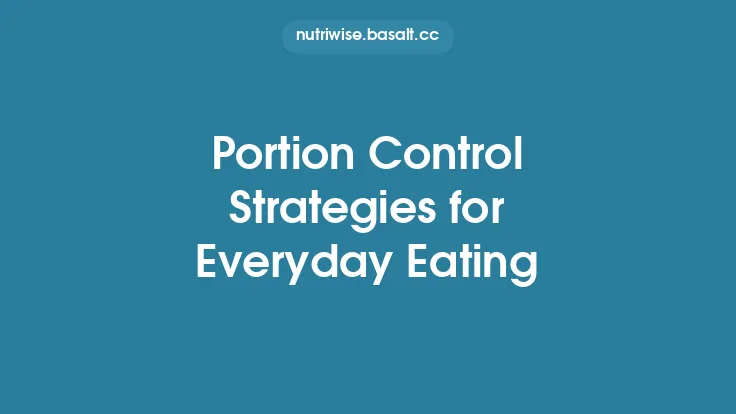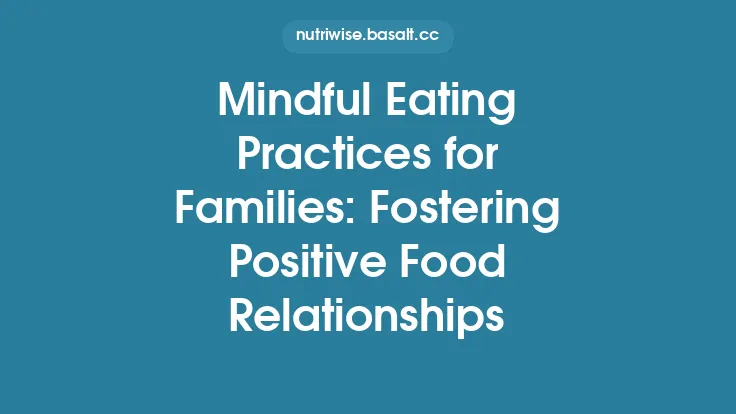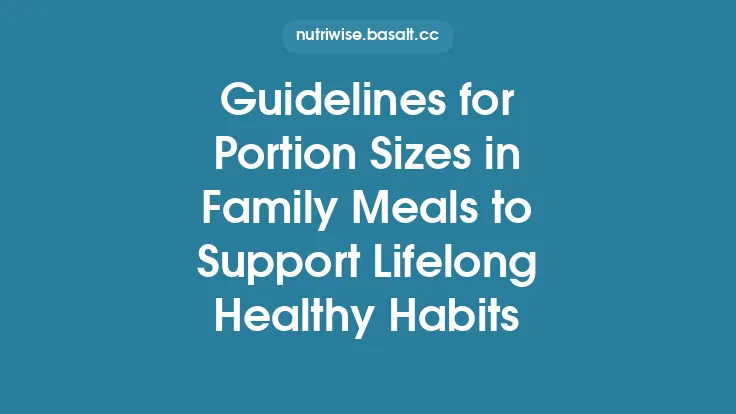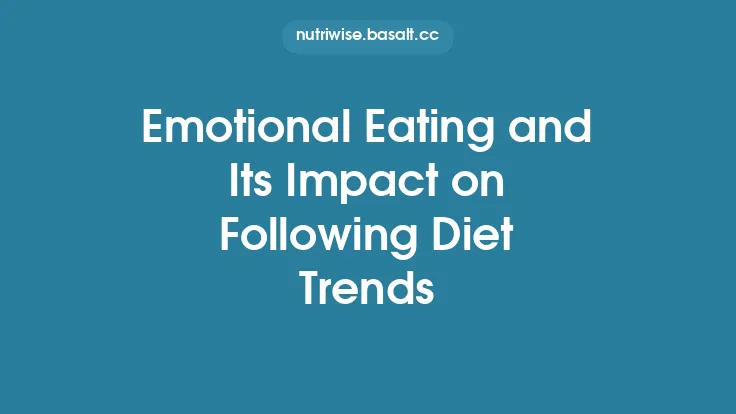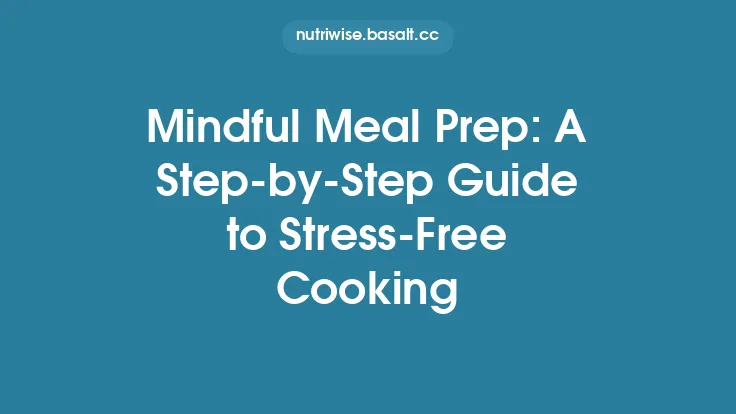When it comes to preventing overeating, the most powerful tool isn’t a new kitchen gadget or a strict calorie‑counting system—it’s the way we relate to the food on our plates. Mindful eating and genuine awareness of portion size tap into the body’s natural signals, allowing us to enjoy meals fully while naturally limiting excess. By shifting focus from external rules to internal cues, we can create a sustainable eating pattern that supports health, satisfaction, and long‑term balance.
Understanding Mindful Eating: Definition and Core Principles
Mindful eating is the practice of bringing full, non‑judgmental attention to the experience of eating. It involves noticing the taste, texture, aroma, and visual appeal of food, as well as the internal sensations of hunger and fullness. The core principles include:
- Present‑Moment Awareness – Directing attention to the act of eating rather than multitasking or scrolling.
- Non‑Judgmental Observation – Accepting thoughts and feelings about food without labeling them “good” or “bad.”
- Intentionality – Choosing to eat with a purpose, whether it’s nourishment, pleasure, or social connection.
- Self‑Compassion – Treating oneself kindly when cravings arise or when a meal doesn’t go as planned.
When these principles are consistently applied, the mind becomes a reliable guide for how much to eat, reducing the reliance on external portion rules.
The Science Behind Hunger, Satiety, and Mindful Awareness
Our bodies regulate energy intake through a sophisticated network of hormones and neural pathways:
| Hormone | Primary Role | Effect on Eating |
|---|---|---|
| Ghrelin | Signals hunger | Increases appetite; peaks before meals |
| Leptin | Signals satiety | Decreases appetite; reflects long‑term energy stores |
| Peptide YY (PYY) | Satiety hormone released after eating | Slows gastric emptying, promoting fullness |
| Cholecystokinin (CCK) | Released by the small intestine | Reduces meal size by signaling fullness |
Mindful eating enhances the sensitivity of these signals. By slowing down, chewing thoroughly, and paying attention to the sensory qualities of food, the brain receives clearer feedback from the gastrointestinal tract, allowing ghrelin to subside and satiety hormones to rise at the appropriate time. Research shows that participants who practice mindfulness during meals report lower post‑meal hunger and consume fewer calories without feeling deprived.
Recognizing Internal Cues: Hunger and Fullness Scales
A practical way to translate physiological signals into actionable decisions is the 10‑point hunger/fullness scale:
| Scale Point | Description |
|---|---|
| 0 | Starving, dizzy, weak |
| 1‑2 | Very weak, pre‑meal cravings |
| 3‑4 | Slightly hungry, ready to eat |
| 5 | Neutral, neither hungry nor full |
| 6‑7 | Satisfied, comfortably full |
| 8‑9 | Very full, may feel uncomfortable |
| 10 | Uncomfortably stuffed, nauseous |
How to use it:
- Before eating: Rate your current hunger. Aim to start a meal when you’re at a 3–4.
- During eating: Pause after each few bites and reassess. If you reach a 6–7, consider stopping.
- After eating: Note any lingering sensations. A 5–6 indicates a balanced meal; a 8+ suggests over‑consumption.
Training yourself to reference this scale cultivates a mental “stop‑light” system that replaces guesswork with a reliable internal gauge.
Strategies to Cultivate Mindful Eating Habits
Pause and Breathe Before Eating
- Set an intention – Silently state why you are eating (e.g., “I’m eating to fuel my body”).
- Take three deep breaths – Inhale through the nose, exhale through the mouth, allowing the nervous system to settle.
- Check the hunger scale – Confirm that you are truly hungry before proceeding.
Engage All Senses During the Meal
- Sight: Observe colors, shapes, and arrangement.
- Smell: Inhale the aroma; note any memories it evokes.
- Taste: Identify primary flavors (sweet, salty, bitter, umami, sour).
- Texture: Notice crunch, creaminess, chewiness.
- Sound: Listen to the crunch of a fresh vegetable or the sizzle of a sauce.
By deliberately focusing on each sense, the brain registers a richer experience, which promotes satisfaction with smaller quantities.
Bite‑by‑Bite Check‑In
After every 5–7 bites:
- Pause – Place utensils down.
- Assess – Re‑rate fullness on the 10‑point scale.
- Decide – Continue if you’re below 6; stop if you’re at 6 or above.
This micro‑monitoring prevents mindless continuation of a meal once satiety signals have emerged.
Managing External Triggers That Lead to Overeating
Distraction Reduction
- Turn off screens – TV, phones, and computers can delay the perception of fullness by up to 20 minutes.
- Create a dedicated eating space – A calm, clutter‑free table signals to the brain that it’s time to focus on food.
Emotional Awareness and Stress Management
- Identify emotional cues – Before reaching for food, ask, “Am I hungry, bored, anxious, or lonely?”
- Alternative coping strategies – Short walks, breathing exercises, or journaling can satisfy emotional needs without calories.
Social Situations and Mindful Choices
- Plan ahead – Decide on portion sizes before attending gatherings.
- Use the “plate half‑full” rule – Fill half the plate with vegetables, a quarter with protein, and a quarter with complex carbs, then adjust based on hunger cues. (Note: This is a conceptual framework, not a visual hand/plate guide.)
- Practice polite refusal – “I’m satisfied, thank you,” or “I’ll have a smaller portion, please,” can be delivered confidently with prior rehearsal.
Planning Meals with Mindful Portion Awareness
Pre‑Meal Intentions
Write a brief note in a meal planner:
- “I will eat until I feel comfortably full (scale 6).”
- “I will savor each bite for at least 20 seconds.”
These written commitments reinforce mindful behavior.
Portion Visualization Without Relying on Hand/Plate Guides
Instead of measuring, imagine the energy density of the food:
- Low‑density foods (e.g., broth‑based soups, leafy greens) occupy larger volumes but contain fewer calories, allowing larger portions without over‑eating.
- High‑density foods (e.g., nuts, cheese) are more calorie‑dense; visualize a smaller “mouthful” that still feels satisfying.
Using Time‑Based Cues
- 20‑Minute Rule: Eat slowly, aiming to finish the meal within 20 minutes. This aligns with the average time needed for satiety signals to travel from the gut to the brain.
- Set a timer for the first 10 minutes; after it rings, pause and reassess hunger.
Mindful Eating Practices for Specific Contexts
At Home
- Serve from the kitchen, not the table. This creates a physical barrier that encourages conscious portion selection.
- Re‑heat leftovers in a separate dish rather than pulling the entire pot onto the table, reducing the temptation to over‑serve.
In Restaurants and Take‑Out
- Order a starter instead of a full entrée to moderate portion size.
- Ask for sauces and dressings on the side so you can control the amount used.
- Box half of the meal before you start eating; this instantly creates a visual cue for a smaller portion.
During Travel
- Pack portable snacks (e.g., a small portion of fruit, a handful of seeds) to avoid impulsive purchases.
- Hydrate first – a glass of water can reduce false hunger signals that often arise from travel fatigue.
Leveraging Journaling and Self‑Reflection to Strengthen Portion Awareness
- Meal Log – Record what you ate, portion size (using the hunger/fullness scale), and any emotions present.
- Pattern Review – Weekly, identify trends such as “I tend to overeat when stressed” or “I stop eating at a 6 when I’m alone but continue to 8 in group settings.”
- Goal Adjustment – Based on insights, set specific, achievable targets (e.g., “Next week, I will pause after 10 bites and check my fullness level”).
Writing reinforces learning and provides a concrete reference for future decisions.
Incorporating Mindful Eating into Long‑Term Lifestyle
Habit Loop Re‑Engineering
- Cue: The sight of a plate or the time of day.
- Routine: Mindful pause, sensory engagement, hunger check.
- Reward: Satisfaction from a well‑digested, enjoyable meal.
By consciously inserting the mindful pause into the routine, the brain rewires the habit loop to favor awareness over automatic consumption.
Periodic Review and Adjustment
Every month, conduct a brief audit:
- What worked? (e.g., “The 20‑minute rule reduced my portion size by 15 %.”)
- What needs tweaking? (e.g., “I still overeat during evening TV.”)
- New strategies: Introduce a different mindfulness cue, such as a short meditation before dinner.
Common Pitfalls and How to Overcome Them
| Pitfall | Why It Happens | Practical Fix |
|---|---|---|
| Rushing through meals | Time pressure, multitasking | Schedule a minimum 20‑minute block for each main meal; set a gentle alarm as a reminder. |
| Confusing “full” with “satisfied” | Cultural conditioning to finish everything on the plate | Practice the “leave‑something‑behind” test: after a meal, ask if you could comfortably eat a small additional bite. |
| Relying on external portion tools | Habitual dependence on measuring cups or visual guides | Shift focus to internal cues; use a brief hunger/fullness check before reaching for any tool. |
| Emotional eating loops | Stress, boredom, loneliness | Develop a “stress‑to‑mindfulness” protocol: 5‑minute breathing, then a quick journal entry before deciding to eat. |
| Social pressure to over‑serve | Desire to appear generous or fit in | Pre‑plan a modest portion and politely share the remainder; practice assertive language in low‑stakes settings. |
Bringing It All Together
Mindful eating and portion awareness are not about strict rules or counting every gram; they are about reconnecting with the body’s innate wisdom. By cultivating present‑moment attention, honoring internal hunger and fullness signals, and strategically managing external triggers, you create a resilient framework that naturally curbs overeating. The result is a more enjoyable relationship with food, better energy balance, and a sustainable path toward long‑term health.
Embrace the practice one meal at a time, and let the subtle cues of your body guide you toward the portion that truly satisfies.
